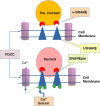The glutamatergic synapse: a complex machinery for information processing
- PMID: 34603541
- PMCID: PMC8448802
- DOI: 10.1007/s11571-021-09679-w
The glutamatergic synapse: a complex machinery for information processing
Abstract
Being the most abundant synaptic type, the glutamatergic synapse is responsible for the larger part of the brain's information processing. Despite the conceptual simplicity of the basic mechanism of synaptic transmission, the glutamatergic synapse shows a large variation in the response to the presynaptic release of the neurotransmitter. This variability is observed not only among different synapses but also in the same single synapse. The synaptic response variability is due to several mechanisms of control of the information transferred among the neurons and suggests that the glutamatergic synapse is not a simple bridge for the transfer of information but plays an important role in its elaboration and management. The control of the synaptic information is operated at pre, post, and extrasynaptic sites in a sort of cooperation between the pre and postsynaptic neurons which also involves the activity of other neurons. The interaction between the different mechanisms of control is extremely complicated and its complete functionality is far from being fully understood. The present review, although not exhaustively, is intended to outline the most important of these mechanisms and their complexity, the understanding of which will be among the most intriguing challenges of future neuroscience.
Keywords: AMPA; Brain information processing; EPSC; EPSP; Glutamatergic synapse; LTD; LTP; NMDA; Synaptic information processing; Synaptic modeling; Synaptic transmission; dendritic integration; dendritic spines.
© The Author(s), under exclusive licence to Springer Nature B.V. 2021.
Figures







Similar articles
-
Synaptic dendritic activity modulates the single synaptic event.Cogn Neurodyn. 2021 Apr;15(2):279-297. doi: 10.1007/s11571-020-09607-4. Epub 2020 Jul 1. Cogn Neurodyn. 2021. PMID: 33854645 Free PMC article.
-
Properties of transmission at a giant glutamatergic synapse in cerebellum: the mossy fiber-unipolar brush cell synapse.J Neurophysiol. 1995 Jul;74(1):24-42. doi: 10.1152/jn.1995.74.1.24. J Neurophysiol. 1995. PMID: 7472327
-
Multisynaptic cooperation shapes single glutamatergic synapse response.Brain Res. 2018 Oct 15;1697:93-104. doi: 10.1016/j.brainres.2018.06.016. Epub 2018 Jun 18. Brain Res. 2018. PMID: 29913131
-
A unified model of the presynaptic and postsynaptic changes during LTP at CA1 synapses.Sci STKE. 2006 Oct 10;2006(356):re11. doi: 10.1126/stke.3562006re11. Sci STKE. 2006. PMID: 17033044 Review.
-
LTD, LTP, and the sliding threshold for long-term synaptic plasticity.Hippocampus. 1996;6(1):35-42. doi: 10.1002/(SICI)1098-1063(1996)6:1<35::AID-HIPO7>3.0.CO;2-6. Hippocampus. 1996. PMID: 8878740 Review.
Cited by
-
Hippocampus Insulin Receptors Regulate Episodic and Spatial Memory Through Excitatory/Inhibitory Balance.ASN Neuro. 2023 Jan-Dec;15:17590914231206657. doi: 10.1177/17590914231206657. ASN Neuro. 2023. PMID: 37908089 Free PMC article.
-
A Pregnancy and Childhood Epigenetics Consortium (PACE) meta-analysis highlights potential relationships between birth order and neonatal blood DNA methylation.Commun Biol. 2024 Jan 9;7(1):66. doi: 10.1038/s42003-023-05698-x. Commun Biol. 2024. PMID: 38195839 Free PMC article.
-
Glutamate indicators with increased sensitivity and tailored deactivation rates.bioRxiv [Preprint]. 2025 Mar 31:2025.03.20.643984. doi: 10.1101/2025.03.20.643984. bioRxiv. 2025. PMID: 40196590 Free PMC article. Preprint.
-
The Role of Glutamatergic Neurons in Changes of Synaptic Plasticity Induced by THz Waves.Biomolecules. 2025 Apr 4;15(4):532. doi: 10.3390/biom15040532. Biomolecules. 2025. PMID: 40305272 Free PMC article.
-
Local Thyroid Hormone Action in Brain Development.Int J Mol Sci. 2023 Aug 2;24(15):12352. doi: 10.3390/ijms241512352. Int J Mol Sci. 2023. PMID: 37569727 Free PMC article. Review.
References
Publication types
LinkOut - more resources
Full Text Sources

